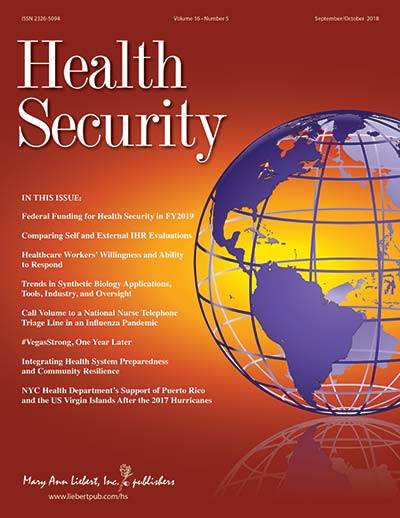Proposed FY2019 federal budget cuts health security funding by 4%
Center News

October 30, 2018 – The Trump administration’s proposed FY2019 budget would cut funding for health security–related programs by 4%, or $636 million, according to researchers at the Johns Hopkins Center for Health Security.
Their analysis of the $13.6 billion requested this year is the Center’s latest annual identification and parsing of federal health security funding for programs in public health, health care, national security, and defense. Center authors Crystal Watson, DrPH, MPH, Matthew Watson, Tara Kirk Sell, PhD, MA, and Daniel Gastfriend published their findings in the October 2018 issue of Health Security.
Two budgets into the Trump presidency, health security funding across the US government has repeatedly been the target of cuts. The Center’s same analysis last year found a proposed $1.25 billion, 9% decrease—the largest proposed in more than a decade, which if enacted would have been more than double the total actual decrease in funding in all years since FY2010. Congress rejected many of those FY2018 cuts and funded health security programs at an estimated $14.24 billion this fiscal year.
“With proposed reductions to many areas of health security, the administration is once again sending a signal that health security is not a high political priority,” said Crystal Watson, a senior scholar at the Center and lead author of the report. “Cuts to essential programs are especially concerning at a time when we are seeing an increase in the emergence of complex health threats to our nation.”
The authors organized programs into 5 categories critical to strengthening health security:
- Biosecurity programs focus on prevention, preparedness, and response to attacks on civilians with biological agents and accidental releases of biological material. They would decrease by 3% from last year.
- Radiological and Nuclear Security programs focus on prevention, preparedness, and consequence management of radiological and nuclear terrorism and large-scale radiological accidents. The FY2019 budget would cut these programs by 6%.
- Chemical Security programs focus on prevention, preparedness, and response to large-scale acute chemical exposures of civilian populations, both intentional and accidental. In this proposed budget, chemical security programs are cut by 2%.
- Pandemic Influenza and Emerging Infectious Diseases programs focus on preparedness and response to large, naturally occurring, and potentially destabilizing epidemics. Funding for this category of programs would increase 8%.
- Multiple-Hazard and General Preparedness programs focus on multiple hazards or on building infrastructure and capacity to respond to large-scale health threats. While these programs would receive the majority (56%) of FY2019 funding, they still face a 7% reduction.
Historical trends and a line-item breakdown of each category are available in supplemental materials on liebertpub.com.
For this annual analysis, Center authors use the broad National Health Security Strategy definition of health security: “[a] state in which a nation and its people are prepared for, protected from, and resilient in the face of health threats.” They gathered and reviewed data from federal agency ‘‘Budgets in Brief,’’ agency congressional budget justifications, and personal contacts with agency representatives. They analyzed nearly 200 health security programs across 12 federal departments, including programs focused on prevention, preparedness, response, and recovery, as well as related research efforts.
This is the 15th year the Center has published an analysis of proposed federal spending on health security-related programs.
About the Johns Hopkins Center for Health Security:
The Johns Hopkins Center for Health Security works to protect people from epidemics and disasters and build resilient communities through innovative scholarship, engagement, and research that strengthens the organizations, systems, policies, and programs essential to preventing and responding to public health crises. The Center is part of the Johns Hopkins Bloomberg School of Public Health and is located in Baltimore, MD.
